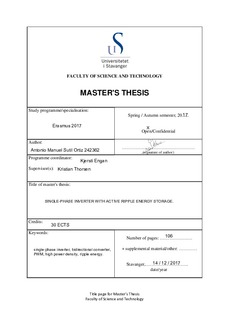| dc.contributor.author | Sutil Ortiz, Antonio Manuel | |
| dc.date.accessioned | 2018-03-02T13:40:28Z | |
| dc.date.available | 2018-03-02T13:40:28Z | |
| dc.date.issued | 2017-12 | |
| dc.identifier.uri | http://hdl.handle.net/11250/2488367 | |
| dc.description | Master's thesis in Computer science | nb_NO |
| dc.description.abstract | It is well known that conventional energy sources such as coal, oil, and natural gas are decreasing and a growing problem of environmental pollution. The renewable energy sources are becoming the best alternative for a clean and inexhaustible energy source, and solar energy is one of the most popular energy sources. Solar energy has gained more and more attention because of its advantages such as abundance, pollution free, renewability and low maintenance. The solar energy is usually obtained from photovoltaic (PV) cell which transform the solar irradiance into direct current (DC), that is electric energy. Since the majority of the electric devices and the main grid, require AC (alternate current) a power converter is needed to convert the DC electricity coming from the PV cell into AC electricity. The most used electronic converter for that is an inverter. Inverters contains semiconductor switches that are often controlled using the pulse width modulation technique, which yields second-order harmonic currents and corresponding ripple voltages on the DC bus. This double line frequency on the DC bus affect the performance of the photovoltaic system. Bulky DC link electrolytic capacitors are typically employed as transient energy buffer to decouple, or smooth out, the pulsating ac power from constant dc power. However, the use of electrolytic capacitor leads to temperature and aging concerns, and this also result in a low power density. A novel active power decoupling method proposed to add a bidirectional buck and boost converter that can store the ripple energy in its inductor and capacitor. This method can effectively reduce the energy storage in the DC link capacitor. This thesis deals with the design of such as bidirectional DC-DC converter and an inverter. The theoretical work mode of the bidirectional converter together with an inverter is studied. The power stages, inverter and bidirectional converter are studied in steady state to dimension the components. These stages are also modelled in their small signal equivalent model to find their transfer functions need to design the control loops. Different control strategies are studied and implemented to achieve the independent controls of the inverter and DC-DC converter. By using LTspice, the simulation results have verified the proposed power decoupling method. | nb_NO |
| dc.language.iso | eng | nb_NO |
| dc.publisher | University of Stavanger, Norway | nb_NO |
| dc.relation.ispartofseries | Masteroppgave/UIS-TN-IDE/2017; | |
| dc.subject | informasjonsteknologi | nb_NO |
| dc.subject | automatisering | nb_NO |
| dc.subject | signalbehandling | nb_NO |
| dc.subject | single-phase inverter | nb_NO |
| dc.subject | high power density | nb_NO |
| dc.subject | ripple energy | nb_NO |
| dc.title | Single-phase inverter with active ripple energy storage | nb_NO |
| dc.type | Master thesis | nb_NO |
| dc.subject.nsi | VDP::Technology: 500::Information and communication technology: 550 | nb_NO |
